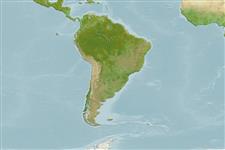Teleostei (teleosts) >
Blenniiformes (Blennies) >
Blenniidae (Combtooth blennies) > Salariinae
Etymology: Scartichthys: Greek, skaritis, -idos = a jewel stone with the colour of the fish scarus (Ref. 45335); crapulatus: Latin, crapulatus = drunk; refers to the purported sleepy or drunken feeling experienced when the flesh of Scartichthys is eaten.
Environment: milieu / climate zone / depth range / distribution range
Ecology
Marine; demersal; depth range 1 - 15 m (Ref. 10696). Temperate
Southeast Pacific: known only from the coast of Valparaiso, Chile.
Size / Weight / Age
Maturity: Lm ? range ? - ? cm
Max length : 11.6 cm SL male/unsexed; (Ref. 10696)
Short description
Identification keys | Morphology | Morphometrics
Known only from the coast, on rocky bottoms (Ref. 10696). Oviparous. Eggs are demersal and adhesive (Ref. 205), and are attached to the substrate via a filamentous, adhesive pad or pedestal (Ref. 94114). Larvae are planktonic, often found in shallow, coastal waters (Ref. 94114).
Life cycle and mating behavior
Maturity | Reproduction | Spawning | Eggs | Fecundity | Larvae
Oviparous, distinct pairing (Ref. 205).
Williams, J.T., 1990. Phylogenetic relationships and revision of the blenniid fish genus Scartichthys. Smith. Contrib. Zool. 492:1-30. (Ref. 10696)
IUCN Red List Status (Ref. 130435: Version 2024-1)
Threat to humans
Harmless
Human uses
Tools
Special reports
Download XML
Internet sources
Estimates based on models
Phylogenetic diversity index (Ref.
82804): PD
50 = 0.5625 [Uniqueness, from 0.5 = low to 2.0 = high].
Bayesian length-weight: a=0.00776 (0.00356 - 0.01695), b=3.00 (2.81 - 3.19), in cm total length, based on LWR estimates for this (Sub)family-body shape (Ref.
93245).
Trophic level (Ref.
69278): 2.7 ±0.2 se; based on size and trophs of closest relatives
Resilience (Ref.
120179): High, minimum population doubling time less than 15 months (Preliminary K or Fecundity.).
Fishing Vulnerability (Ref.
59153): Low vulnerability (10 of 100).
